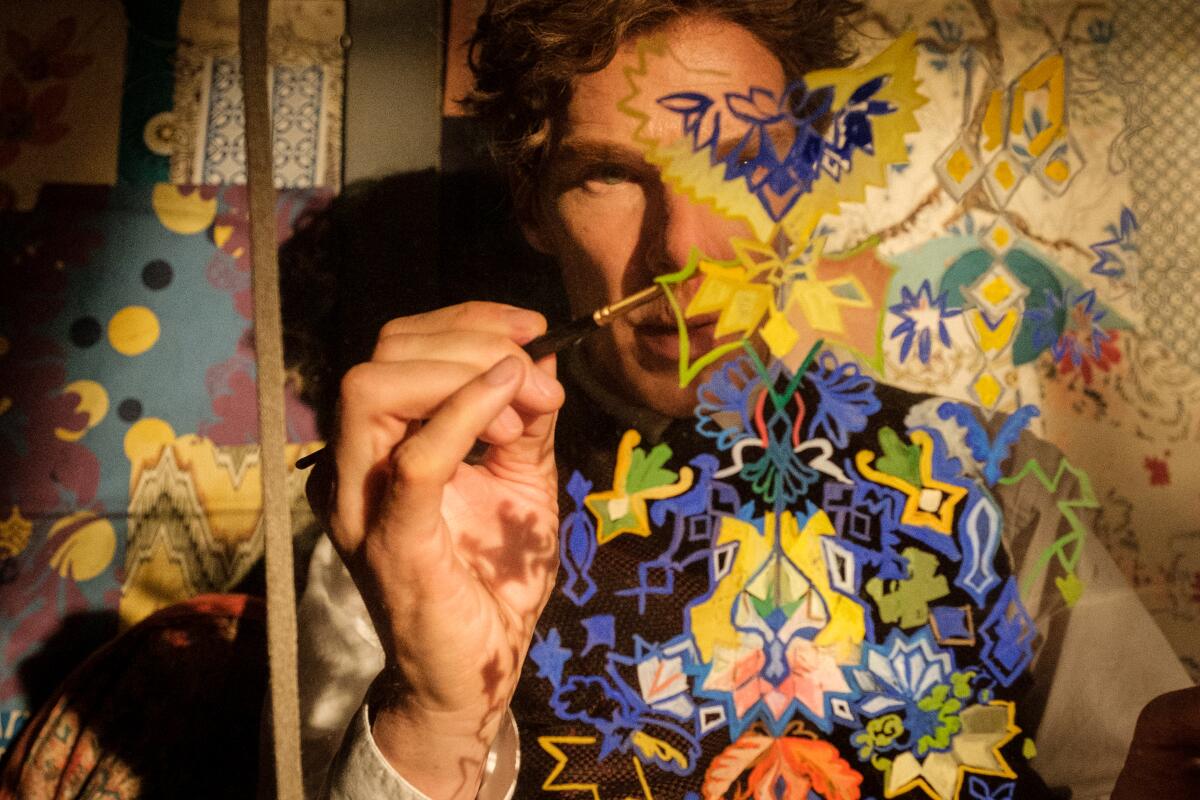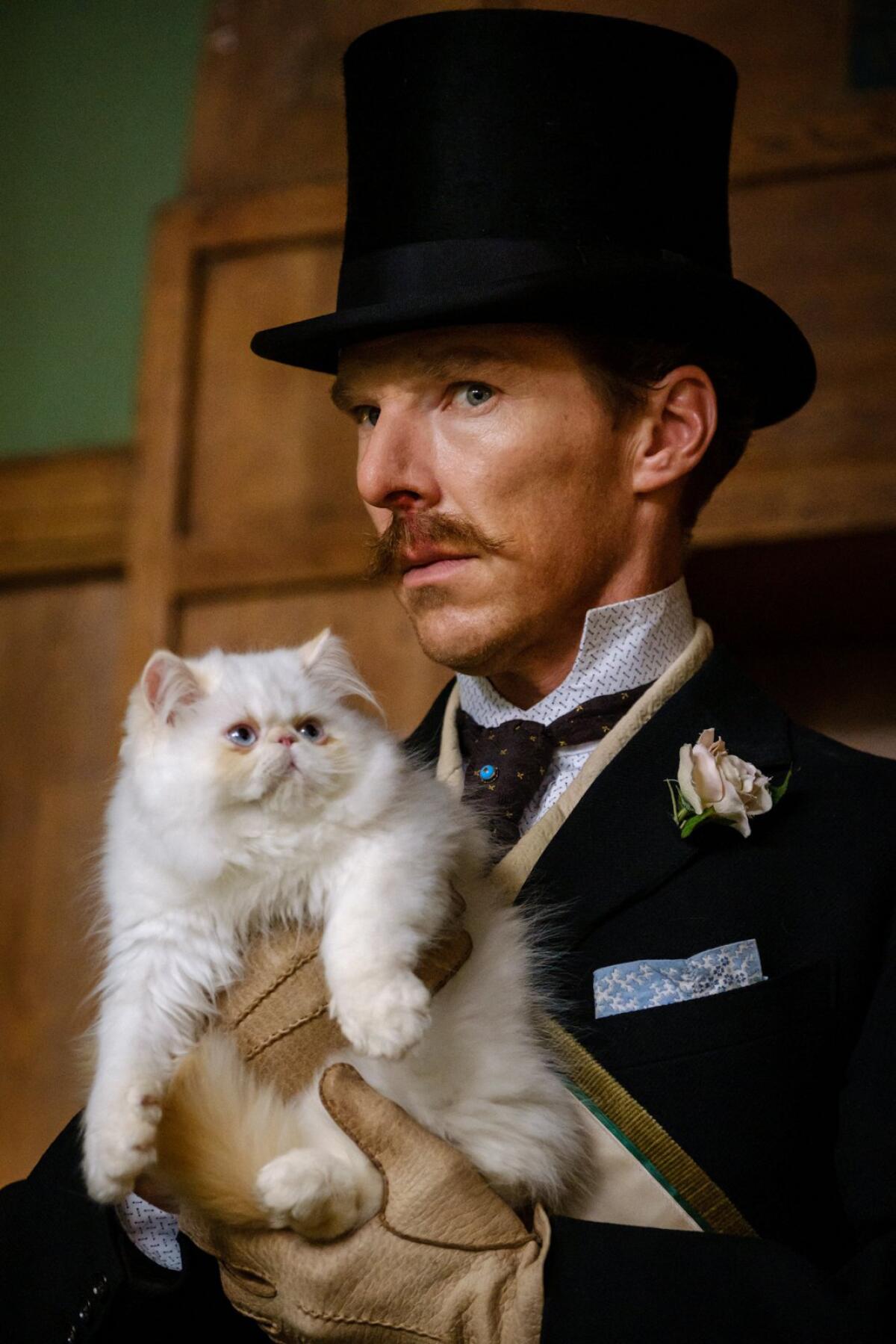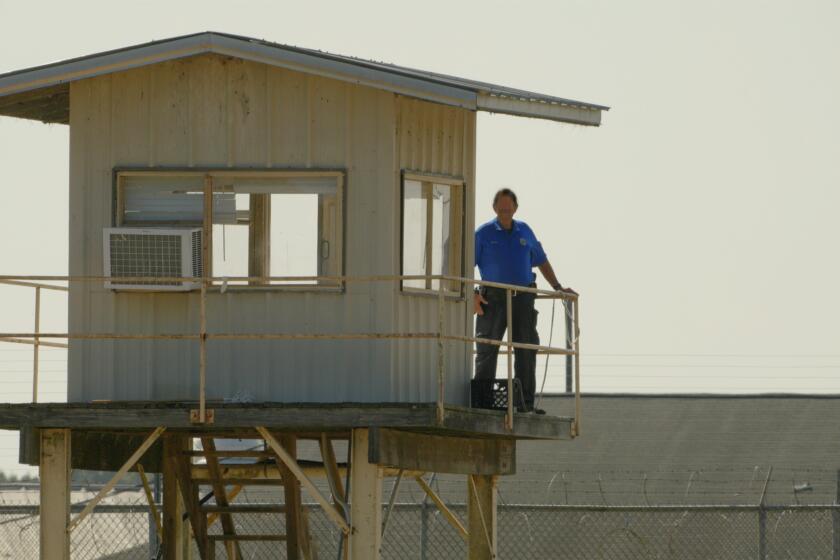Review: I can has Cumberbatch? Cat painter bio-pic ‘Louis Wain’ is no meow-sterpiece

- Share via
The Times is committed to reviewing theatrical film releases during the COVID-19 pandemic. Because moviegoing carries risks during this time, we remind readers to follow health and safety guidelines as outlined by the Centers for Disease Control and Prevention and local health officials.
If you thought the meme-ification of cats was a product of the internet, perhaps you’re unaware of Louis Wain. The Victorian-era polymath artist became famous for his illustrations of anthropomorphized felines in bow ties and bonnets, having tea parties and playing tennis. Later, a bit like the Beatles around the time of “Revolver,” Wain’s kitty-kitsch art turned psychedelic, which became evidence for a posthumous diagnosis of schizophrenia — one still under dispute.
Will Sharpe’s “The Electrical Life of Louis Wain,” co-written by Simon Stephenson, does not attempt to settle that debate, but it does lean into its phantasmagorical potential so that Wain’s turbulent inner life can be exteriorized as an explosion in the period-quirk factory. Tottering unsteadily between mining Wain’s vast repertoire of eccentricities for comedy and slathering them in pathos, the movie winds up so busily whimsical it forgets to actually be about anything. If you don’t know who Louis Wain was before you see it, you’ll only be fractionally more illuminated, and possibly a good deal more irritated, after.
The latest in a string of tormented geniuses to be played by Benedict Cumberbatch — perhaps the foremost actor to capitalize on the tendency to conflate being extremely clever with being very thin and British — the film’s version of Wain comes across as a tic-laden naif who, as he confesses late on, finds living in this world simply more difficult than it is for everyone else. Forever wearing the expression of a man who just snapped out of a stage magician’s trance, he runs erratically, swims ridiculously, boxes comically and speaks through a harelip-covering mustache with all the twitchy, blinky oddness of a bird that’s suddenly found itself in a human body. He does however have his supporters, like Sir William Ingram (a warmly impish Toby Jones), the editor of a London gazette, who overlooks Wain’s unconventionality to focus on his usefully speedy, ambidextrous drawing style.
The illustrations Wain churns out for the newspaper — in between composing operas, bloodying his nose in the boxing ring and indulging his semi-mystical interest in the new science of electricity — just about keep Wain, his mother and five sisters solvent, though in circumstances far reduced from their gentility prior to the death of Wain’s father. With Louis ill-equipped to take up the head-of-the-household position, and his mother vague and ineffectual, his sister Caroline (Andrea Riseborough) has stepped into the breach, and a right one-note nagging harridan it has made of her.

Things briefly perk up when Caroline hires Emily (Claire Foy) as the younger girls’ governess, but if Emily and Louis’ kooky romance and marriage bring Wain his happiest years, the difference in class status and age between them only visits more social disrepute on the Wain family. And then, in a tragedy foreshadowed by Erik Wilson’s swaying, sentimental camerawork in which golden lens flares have the tendency to mist over the image like unfallen tears, the kooky crumbles when Emily is diagnosed with terminal cancer.
This happens on the very same day the couple finds a kitten in their garden, which — very much against the convention of the day — they adopt as a pet. Peter, as the little black-and-white moggie is named, starts to figure in Wain’s drawings, and at Sir William’s encouragement, cats are soon more or less all he draws. These cat pictures, which the unworldly Wain neglects to copyright, bring him transatlantic fame (at one point he visits New York to take up a position for the Hearst corporation). But are they the delightful manifestations of a wistful creative imagination or the nightmarish harbingers of encroaching mental illness?
It’s a question “The Electrical Life of Louis Wain” is not much interested in exploring. Not that the film has any claws at all, but particularly when it comes to Wain’s psychological state, it bats around the issue with the softest of paws. Instead, as misdirection, Sharpe embellishes the story with an entire grandmother’s cabinet of filmmaking tchotchkes, only some of which work. (The filmmaker’s better observed forays into darkly comic descriptions of mental instability include “Black Pond” and the TV series “Flowers.”) One smart touch: the narration, delivered by Olivia Colman with a bedtime-story voice so wry and delightful it sometimes manages to trick you into thinking that what she’s saying is not just a load of hooey.
More often the flourishes serve merely to distract: drive-by cameos from Taika Waititi, Richard Ayoade and Nick Cave; occasional use of olde worlde pinhole-camera imagery to describe Wain’s night terrors; a couple of times late on when a landscape goes mushy and oversaturated, blurring into a synthetic recreation of a painting. Not to mention the bizarre decision to subtitle just one scene of cat dialogue in such cutesy LOLcatspeak (“I are cat” says one, “I like jomping” says another) that you half expect one of them to wonder if they can has cheezburger.
All of this whimsy is applied with so little rigor, and so little actual insight that it quickly becomes tedious, making the film’s runtime feel exponentially longer than it is, without — and this is a crucial flaw for ailurophiles looking for a good time — actually giving us nearly enough cat. Of all the film’s many disappointments this is surely the most egregious. It’s almost enough to make one accuse Sharpe of being — horrors! — a dog person.
'The Electrical Life of Louis Wain'
Rating: PG-13, for some thematic material and strong language
Running time: 1 hour, 51 minutes
Release: Starts Friday at the Landmark, Los Angeles; Laemmle Monica Film Center, Santa Monica; Laemmle Playhouse 7, Pasadena; Laemmle Town Center 5, Encino; streaming Nov. 5 on Prime Video
More to Read
Only good movies
Get the Indie Focus newsletter, Mark Olsen's weekly guide to the world of cinema.
You may occasionally receive promotional content from the Los Angeles Times.










